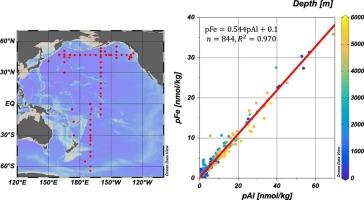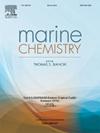Acid-leachability of metals from suspended particles in the Pacific Ocean
IF 2.5
3区 地球科学
Q2 CHEMISTRY, MULTIDISCIPLINARY
引用次数: 0
Abstract
Suspended particles are major carriers of trace metals in seawater, while the cycling mechanisms of particulate trace metals remain largely unclear owing to analytical challenges. In this study, we focused on the acid-leachability of particulate trace metals collected from the Pacific Ocean and investigated their compositional features by measuring the total dissolvable metal (tdM) and dissolved metal (dM) concentrations in unfiltered and filtered seawater samples, respectively. We defined the difference between total dissolvable and dissolved metals as the particulate metal (pM). We investigated the pM time course in acidified bottom waters (pH 1.9) over approximately two years. pM increased in two stages and reached equilibrium within a few years. In the field study, we stored acidified seawater samples at least two years before analysis. We compared pM with total particulate metal (tpM) concentrations in the same samples collected from 11 stations in the subarctic Pacific. The tpM concentrations were determined by particle filtration followed by total digestion using strong acids, including HF. The results indicate that pAl and pFe are nearly equivalent to tpAl and tpFe, respectively. Many metals in the suspended particles, including clay minerals, are highly acid-leachable during long-time storage. By compiling our pM data observed in the Pacific Ocean and its marginal seas (approximately 1500 samples), we found that the average pM/dM ratio across the Pacific is 9 for Al and 4 for Fe. Although pAl and pFe exhibit strong linear correlations, their concentrations and regression slopes are spatially variable, reflecting differences in sources and fluxes.

太平洋悬浮颗粒中金属的酸浸性
悬浮颗粒是海水中微量金属的主要载体,但由于分析方面的挑战,颗粒微量金属的循环机制在很大程度上仍不清楚。本研究通过测定未过滤和过滤海水样品中总溶解金属(tdM)和溶解金属(dM)浓度,研究了太平洋海水中颗粒状微量金属的酸浸性,并探讨了其组成特征。我们将总可溶金属和溶解金属的区别定义为颗粒金属(pM)。在大约两年的时间里,我们研究了酸化水底(pH值1.9)的pM时间过程。pM分两个阶段增加,并在几年内达到平衡。在实地研究中,我们在分析前将酸化的海水样本至少保存了两年。我们比较了从亚北极太平洋11个站点收集的相同样品中的pM和总颗粒金属(tpM)浓度。采用颗粒过滤法测定tpM浓度,然后用强酸(包括HF)进行总消解。结果表明,pAl和pFe分别与tpAl和tfe几乎相等。悬浮颗粒中的许多金属,包括粘土矿物,在长期储存期间极易酸浸。通过汇编我们在太平洋及其边缘海域观测到的pM数据(大约1500个样本),我们发现整个太平洋的平均pM/dM比值为Al为9,Fe为4。尽管pAl和pFe表现出很强的线性相关性,但它们的浓度和回归斜率在空间上是可变的,反映了来源和通量的差异。
本文章由计算机程序翻译,如有差异,请以英文原文为准。
求助全文
约1分钟内获得全文
求助全文
来源期刊

Marine Chemistry
化学-海洋学
CiteScore
6.00
自引率
3.30%
发文量
70
审稿时长
4.5 months
期刊介绍:
Marine Chemistry is an international medium for the publication of original studies and occasional reviews in the field of chemistry in the marine environment, with emphasis on the dynamic approach. The journal endeavours to cover all aspects, from chemical processes to theoretical and experimental work, and, by providing a central channel of communication, to speed the flow of information in this relatively new and rapidly expanding discipline.
 求助内容:
求助内容: 应助结果提醒方式:
应助结果提醒方式:


